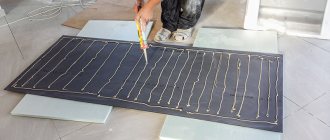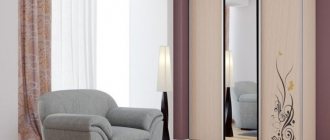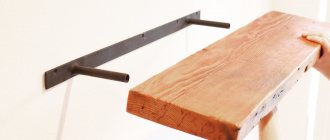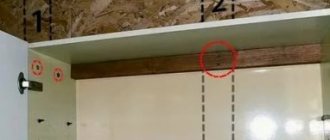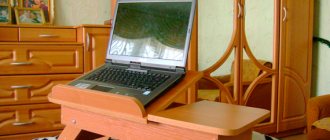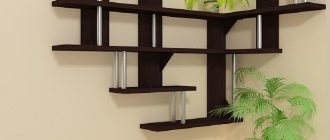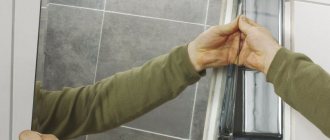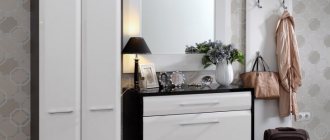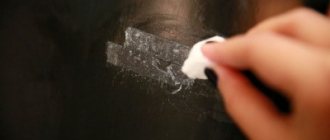To make changes to the interior of the room, it will be enough to install a mirror on the furniture. This will help visually enlarge the room and make it brighter. Attaching a mirror to the cabinet door will not be difficult, but before performing the work, you need to familiarize yourself with the execution process and foresee what materials will be needed.
How to hang a mirror on hooks
The first method is suitable for mirrors with frames or small mirrors without them. As a rule, such mirrors already have some kind of fastenings on the back, like D-rings or loops, and all you have to do is make a counter part for them - one or more hooks. In order to hang such a mirror on the wall, you should follow these steps:
- Find out what material the wall on which you want to hang the mirror is made of. This will determine whether your wall can support the weight of the mirror and what screws and dowels you will need to use. For example, if you want to hang a mirror on a plasterboard wall, you will need special dowels, the so-called “butterflies”.
- Weigh your mirror. Depending on the weight, not only fastenings will be selected, but also hooks, since they also have restrictions on the weight they can withstand.
- Place the mirror against the wall in the place where you plan to hang it. Mark the position of its top and corners on the wall with a pencil. You can also first attach a level to the edge of the mirror and check whether it will hang vertically in this position.
- You need to mark on the wall where the mountings on the mirror will be located. To do this, measure all the distances from the edges of the mirror to the fastenings, as well as the distance between them, if there are several of them. Then mark their location on the wall, transferring all measurements onto it. If you have a small mirror with a wire or ribbon loop at the center back, you'll only need one hole in the wall and may even be able to get by without a hook. To figure out where this hole will need to be drilled, measure the width of your mirror and mark a point in the middle of that line. Then pull the loop as high as possible from this point and measure the distance from its top edge to the top edge of the mirror itself. Transfer the results of the measurements to the wall using the same pencil.
- Mark on the wall where the holes for the screws of the hooks should be - this can be done by attaching the hooks themselves to the wall and aligning them with the marks for the location of the fasteners on the back side of the mirror.
- Drill holes in the marked places for the screws intended for attaching the hooks. Use a drill bit of the correct thickness to suit your wall material. If the wall material allows you to screw in a screw without a dowel, that's good. If not, drill holes immediately to match the diameter of the dowels. Using them, screw on the hooks.
- Before hanging the mirror on the wall, glue protective fabric pads to the back corners and centers of the sides - these are often sold in furniture stores, for example, for gluing to furniture legs so that it does not scratch the floor.
Methods of installation on a plasterboard surface
Depending on the weight of the decorative element, the mirror can be installed in several ways:
- using dowels;
- adhesive mixtures;
- fixation with double-sided tape;
- installation using wooden slats.
Using dowels
The method allows the installation of products weighing more than 20 kg. As fastening elements, ordinary dowels or a butterfly dowel are most often used (after screwing into the wall cavity, the sheet opens and compresses inside the drilled hole on both sides):
- measure the distance between the loops on the back of the mirror;
- mark the mounting points on the drywall;
- drill holes according to the marks;
- mount dowels, screw in hooks or install brackets;
- hang the mirror on the mounts.
Adhesive mixtures
The method is used for installation of decorative elements weighing up to 20 kg. As an adhesive, it is most convenient to use liquid nails with a chemically neutral composition, intended for working with mirrors - the composition is safe for the amalgam of the reflective fabric and has a short setting time:
- thoroughly clean the area of the working surface selected for installation from dust and other contaminants using a dry sponge;
- place the mirror vertically and apply liquid nails (in stripes, snakes, dots) to the back side along the entire surface and perimeter, keeping a small distance from the edges (about 1 cm) so that the excess mixture does not go beyond the border of the canvas;
- press the product against the drywall, adjust the position using a level;
- the mirror should be in a fixed position for 24 hours (until the solution dries completely), so make a supporting structure in advance or install a support rail on the wall.
Double-sided tape
The easiest way that allows you to mount light mirrors weighing up to 5 kg:
- clean and treat the back of the mirror with alcohol;
- apply marking lines to the wall, degrease the drywall area with soapy water, rinse it off and dry the surface;
- glue strips of tape along the entire surface and perimeter of the decorative element;
- Place the mirror on the surface and press with slight force.
Wooden slats
The method allows you to fix the reflective sheet and evenly distribute the load on the drywall:
- Draw marking lines corresponding to the upper and lower height points of the product.
- Install the wooden slats using dowel nails according to the marks. To strengthen the structure, you can attach the strips with self-tapping screws to the metal frame profile.
- Screw the hooks into the upper part, apply an adhesive mixture to the lower part and install the reflective sheet.
If the decorative element is large, the design can be supplemented with a rail connecting the upper and lower parts of the support. This strip is also covered with glue before installing the mirror.
How to hang a mirror on a wall without a frame - Masters Club
A mirror is a must-have element in every home. It would seem that what is difficult about installing it? But when the need arises to hang it, questions arise.
Nowadays there is a huge selection of mirrors in stores: large, small, with designer designs. Some of them do not have fastening elements at all, which raises a logical question about installation. How to carry out installation?
DIY fastening
Do-it-yourself installation does not require special skills; all existing methods can be performed independently. The most common and familiar method is on nails. But they leave a mark in the wall, and later, if you remove the mirror, the hole will need to be sealed. Some people prefer the painting method: they are attached to the surface using a special thread.
Mounting methods
- Glue.
- On special holders.
- For self-tapping screws to a furniture door or for fastening with a plastic compensator.
- Using a decorative profile.
- There are silt nails on the dowels.
Installation recommendations:
- In a room where there is little light, place a mirror opposite the window. It will make it lighter;
- a large canvas will visually expand the room;
- It is not advisable to place it in the kitchen near the stove;
- in the children’s room it is better to cover the mirror with a protective film; if it breaks, no one will get hurt;
- It is convenient to place a full-length canvas in the hallway;
- The direction of the light should not be direct, otherwise the canvas will quickly fade.
Installation without drilling
- Only a flat surface is suitable for mounting. If the wall has defects, then the product will be in a stressed state and may eventually burst;
- This method of fastening is not suitable for glossy surfaces or in the bathroom, because it is not resistant to moisture and will begin to peel off over time.
Choose high-quality glue, the famous ones, “Bison”, “Ravak”.
How to hang a mount on dowels
- At home, attach the canvas to the desired surface, make marks at the attachment points. Using a drill, select a nozzle for concrete, make a hole up to ten millimeters deep and secure the sleeves.
- Next, apply the mirror and screw in the metal screws.
- Install the clamping elements.
- Plugs are placed on top.
After finishing work, check all elements for strength. Everything must be sustainable.
If the work is performed on a surface decorated with plasterboard, then you need to use special butterfly dowels. They have longitudinal ribs that prevent the dowel from turning, and a locking bolt holds it in place and prevents the fastening from falling into the wall.
Using the same scheme, the canvas is attached to a fishing line or rope. First, dowels, anchors or hooks are installed, and then suspended.
How to attach without nails
Canvas without a frame can be secured in several ways:
- Glue. The working technique is the same as with mirrors with a frame: prepare the surface, level it, remove dust, make markings and install. This method is suitable for partially decorating a wall.
- Profile. The canvas is inserted into a metal profile. This makes it convenient to decorate large surfaces. Working technique: prepare the surface, install the profile, apply a silicone seal to the edge of the glass so that the mirror fits into the grooves more easily. The canvas is inserted and pressed to secure it. All other parts are installed by analogy.
Installing large mirrors: features and recommendations
It is better to entrust the installation of large mirrors to a specialist, as this requires skills. The installation method depends on the size and characteristics of the canvas. The main method of fastening is using hardware and special fasteners.
- Use glue that has not expired.
- Do not touch the mirror for several days until it is completely fixed.
- Prepare the surface correctly: level and eliminate defects.
- Secure a heavy mirror additionally mechanically. You can add small fasteners or make a small stand.
How to stick to a wall with wallpaper
It is better to install a mirror on a surface with wallpaper using fittings, this will ensure safety.
For this purpose, special fasteners are used in the form of brackets with pads. The canvas is attached to brackets, and the linings act as a seal.
Is it possible to hang a full-length mirror on the wall without mounting?
You can install a full-length mirror using silicone sealant or glue; the technique is the same as with the glue method.
Mirrors in the interior are an essential element of any apartment. Choose a location for installation in advance and carefully approach the installation process.
"Golden rules" of installation
To make the mirror really shine in the interior, follow the basic rules when installing:
- in a room where there is little light, the reflective surface should be installed opposite the window. The room will become brighter;
- A very large mirror will help to visually expand the space;
- do not place the product near the stove in the kitchen;
- In the children's room, cover the structure with protective film. If the reflective part breaks, young family members will not be hurt;
- In the corridor, install a full-length canvas - it’s convenient;
- Do not direct the light from the lamp directly into the reflective part, it will quickly dim;
- do not forget about degreasing,
- Hang mirrors that are too large on different types of fasteners - combine, for example, self-tapping screws and “silicone glue.”
Liquid nails for mirrors and other installation features
The role of mirrors in a person’s life is very diverse; they serve us to evaluate appearance, decorate a room, and are even used in magic. Let the sorcerers ask the last question, but we will consider the most popular installation methods.
Step 1: Select a location
Whatever fastening method is chosen, it all starts with selecting the most suitable location. Thus, keep in mind that the light should fall on the face and not on the subject itself. In order for it to serve as long as possible, you should attach it at the maximum distance from heat sources. Well, mirrors in the bathroom, which are located above the sink, need to be installed at least 20 cm above it, otherwise the surface will always be dirty from drops of water.
Step 2: Buying a Mirror
If you want to see your reflection in full height, then the accessory must be at least 140 cm in height. Having bought a mirror 60 cm high, you will see yourself from the waist up. Well, the most common specimens for restrooms are usually about 40 cm.
Step 3: Choosing a Mounting Method
1. Liquid nails for mirrors, assembly adhesive or special double-sided tape will ensure reliable fastening of the accessory without damaging the wall surface. You just need to decide on the location and apply glue to the back surface of the mirror in strips no more than 7 mm wide in 5 cm increments; for this you will need a mounting gun. The distance from the last strips to the edge should be 4 cm. Apply the product to the wall and press it. Afterwards, do not forget to remove any excess glue that has come out on the sides. In general, different products do not always have the same application technology, so before you start working, be sure to read the instructions on the package.
2. Fastenings for a mirror without drilling the product itself, as well as other accessories, require drilling the wall, so you will need a hammer drill. Having made preliminary markings on the surface, we make a hole into which the dowel must be inserted. Please note that the holes in the wall must match the mounting holes on the accessory itself. Rubber gaskets must be installed between the mirror and the wall, as well as its front side and the plug, so check that they are included in the kit.
3. If the product itself does not have mounting holes, then you need to familiarize yourself with how to drill a mirror. This work cannot be classified as simple, but it is quite doable, all you need is a diamond drill. To prevent cracks or other defects from appearing on the surface, it should be constantly moistened with water to prevent heating. Then, having sanded the holes, you can proceed directly to installation.
4
Another popular method of installing mirrors is flush with the tiles; in this regard, it is very important to choose its thickness. It must match the thickness of the tile
Having leveled the place where the mirror will be installed with putty, you need to work on the border, first the bottom, then the top, and lastly the sides. The accessory can be installed only after the curb tiles are securely fastened. Next, use a ribbed spatula to apply a thick layer of glue to the wall and place the bottom edge of the product, not forgetting to insert crosses between it and the tile. Then we press the remaining part of the mirror so that it is flush with the tile, and keep it in this state for fifteen minutes. After removing traces of glue, we rub the seams.
What glue should I use?
There is a huge selection of adhesives for attaching mirrors. The most popular of all is the Bostik 2750MS. This glue has excellent performance characteristics. There is no need to apply a primer underneath. It is suitable for gluing various surfaces. The glue does not lose its adhesive properties and does not corrode the mirror amalgam.
When working with ceramic tiles, it is better to choose a polymer-based adhesive. An example is the hybrid sealant Bostik 2720MS. Compared to silicone compounds, its adhesive properties are an order of magnitude higher, and it is not at all afraid of moisture. This glue can be used for decades. Its characteristics will remain the same.
The mirror can be hung without fastenings. This article discussed the main installation methods; which one to choose is up to you.
Recommendations for placement
When choosing a method for attaching a mirror, based on the wall material and its reliability, do not forget about the place in which this mirror will look most advantageous. It's no secret that sometimes it is not possible to place the mirror canvas where you want. The reason may be the design features of the room, lack of footage.
In small apartments, each piece of furniture has its own place, which limits the space for the mirror itself
To simplify the task, you can pay attention to some nuances:. In a small darkened room, it is worth placing a mirror opposite the window opening to give more light to the room.
A mirror on the entire bedroom wall will double the size of a small room
In a small darkened room, it is worth placing a mirror opposite the window opening to give more light to the room. A mirror on the entire bedroom wall will double the size of a small room.
- You should not hang a glass product in the kitchen near the stove: high temperature and fumes will provoke frequent maintenance and will affect the appearance of the mirror.
- Before hanging the canvas panel in the bathroom, cover its ends and back with a special sealant.
- Place stylized lighting fixtures on the wall near the mirror in the hallway; this will visually expand the walls in the room and give a stunning effect of diffused light.
- You should not hang decorative elements of this type at an angle to a vertical surface, so as not to distort the reflection.
- To properly fix the mirror in the hallway, choose a place where you can look into it at full height and keep in mind that this distance should be at least 1-1.5 m from you.
- The canvas, which has a height of 0.6 m, guarantees a waist-high view, a product from 1.2 m provides a full view of the entire figure. The choice of mounting height for a mirror in the hall will depend on its height and width. The bottom of the mirror for a full-length view should be placed no higher than 0.5 m above the floor level.
- For high-quality gluing of a mirror, the wall must be level. The thin product will adapt to the shape of an uneven wall, since the glass can take the shape of the base. To stick the product correctly and avoid such a nuisance, you need to choose thick glass or level the wall.
Mirror in the closet
Very often, mirrored canvases are hung on closet doors - in the hallway or bedroom. The gluing technology is simple and in many ways similar to the previous method. The first thing to do is to mark the boundaries of the future mirror on the door with a pencil. Next, special glue is applied to the back side; this must also be done along the contour and in the middle in the form of a lattice. Do not forget about double-sided tape, which is glued every 20-30 cm in the form of vertical stripes
It is important to remember that some types of glue set very quickly, so you need to level the mirror as quickly as possible
Save space in the bedroom: install a wardrobe with a mirror
Height above sink
General principles when placing a mirror reflective element inside a bathroom are:
- the upper edge is 10 cm higher than the tallest member of the family;
- the lower edge is at a level of 15 - 20 cm from the side of the sink to avoid constant splashes, streaks, stains;
- width equal to the size of the plumbing fixtures or slightly less;
- glass thickness from 2 mm, otherwise the mirror will be too fragile, but no more than 10 mm, so as not to make the structure heavier.
However, there are nuances in which even these principles are not correct:
- a reflective element can be used in the interior to visually increase the work space;
- Preschool children may require a lower setting, level with their face.
Small-format makeup mirrors with a magnifying effect must be attached taking into account the degrees of mobility and the number of hinged elements.
At what altitude
The installation height of mirrors depends on the installation location and its purpose. In the bathroom it is hung so that the middle of the mirror surface is at eye level. The height of residents may vary, but on average the center is at a height of 160-165 cm from the floor.
Bathroom mirror installation height
When hanging in the hallway or dressing room, mirrors are usually installed long and narrow. In them, a person should be displayed in full height. To do this, its upper edge should be slightly above the head - 3-5 cm. When hanging on cabinet doors, use its upper edge as a guide. If the closet is tall, the mirror is also fixed a few centimeters above the head.
On a brick base
For installation using glue, prepare the surface - if necessary, remove the wallpaper, carefully level it with a primer, followed by sanding. Be sure to clean it and wipe it with an alcohol solution.
Special glue intended for glass with amalgam coating is used according to the instructions. They are applied to the surface not in a continuous mass, but in parallel stripes at equal intervals or in “fat” drops in a checkerboard pattern.
Then the product is pressed tightly and held for about a day until it sets completely.
If, when deciding how to attach a mirror, this method is chosen, you need to remember that it will no longer be possible to remove or rehang it. This is the last place of its “stay” - then it can only be broken up and removed.
When using thick double-sided tape, the surface is prepared. It is glued on the back side of the glass along the perimeter and surface in vertical or horizontal stripes in increments of 5-7 cm. After which the protective film is removed from it and pressed into place.
All this can be easily done with your own hands.
The composition of liquid nails allows you to securely hang the mirror without damaging the decorative surface of the installation site. The strength of this construction adhesive is significantly superior to PVA glue, and some modifications are equivalent to the characteristics of dowels.
The option is very convenient, since there is no need for tools and fasteners, you only need suitable glue.
The surface of the wall cleared for the mirror must be flat, otherwise the fastening will be unreliable.
Hardware is usually used to mount a mirror that has ready-made holes. To do this, you need to drill recesses in the wall along the diameter of the dowel used, 5 mm longer than the length of the self-tapping screw that you plan to use. After drilling, they are cleaned of dust, dowels are installed, the product is attached, and the screws are tightened one by one. Be sure to cover with decorative heads.
When hanging a mirror, you need to pay attention to the shape of the interior element
Work technology
A mirror is glued to a concrete wall like this:
- Turn the mirror back.
- Glue pieces of thick double-sided tape onto it.
- Remove the protective shell/film from it.
- Apply adhesive to the back side along the contour. It is advisable to do this in small pyramids.
- Next, the glue is applied to the surface in equal stripes - 15-20 cm.
- After the adhesive has already been applied, the mirror is pressed tightly against the wall.
- It is advisable to support the canvas with something from below, since the glue will set firmly only after 30-40 minutes. Double-sided tape performs the same function. Until the glue hardens, there is no need to tear off the tape; it will maintain a stable position of the canvas.
The technology of gluing a mirror to a “liquid nail” follows the same principle. The sealant is applied to the back wall of the canvas and waited for some time.
If the mirror is small, then only the contours are processed with a “liquid nail”. Some craftsmen advise using special holders for a while until the sealant hardens.
Installing a mirror with dowels and screws
Fasteners of this type can withstand any weight. So, if you wish, you can even fix the canvas to the entire wall, starting from the ceiling. Installation accessories can be purchased at any hardware store.
The advantages of this installation method include the following:
- strength of fastenings;
- long service life;
- Possibility of installation anywhere.
Installation technology
First, we need to make holes in the mirror sheet for through fasteners. So, there are some ways to make this process easier:
- It is necessary to first rub the mirror with turpentine, and only then drill - this will avoid the appearance of cracks.
- It is better to first make holes in the right place using a diamond glass cutter.
- While working, do not put too much pressure on the drill. All actions must be as careful as possible.
- It is recommended to use an electric drill with adjustable speed, because you will only need to drill the mirror at minimum speed.
Step-by-step instruction
Step 1. First of all, we treat the surface and let it dry normally. The mirror should be placed on as flat a surface as possible. Next, you need to mark the hole using a marker.
We put markings on the canvas
Step 2. Next, you need to make a small rim of plasticine around the future hole, into which you can pour water, and only after that should you start drilling.
It is important to ensure that the drill is always in water. This way it will overheat much less
Step 3. Once the hole is ready, you will need to sand it down with sandpaper.
Sand the hole with sandpaper
Next, you will need, as in the previous case, to make holes in the wall, and then place fasteners there and only then install the canvas itself.
Mirror holders
Quite often, mirrors are hung on the wall using special devices. This includes various brackets and clamps.
These fabric holders come in two types:
- Through. They are used if the canvas already has a corresponding hole. Essentially, these are the same self-tapping screws, but only with decorative overlays. They come in various shapes and sizes.
- Non-through. Holders of this type are attached both to the cabinet door and to the wall, and the mirror is already fixed through the edges. They can be attached tightly or left a small gap (the second option is especially suitable in the case of curved walls).
Such devices have the following advantages:
- they can be installed in any room using mirror sheets of various sizes;
- such fasteners have maximum stability and are “indifferent” to temperature changes and high air humidity;
- if necessary, the mirror can be dismantled without any damage;
- Clamps and brackets are easy to attach to any surface.
The only disadvantage is the cost of fasteners, which will be higher than that of glue or double-sided tape.
Installation features: step-by-step instructions
Installing a mirror using such auxiliary fittings is extremely simple. Any person can handle such actions if desired.
Step 1. First of all, mark the installation locations of these mounts on the wall
It is important to take accurate measurements here, otherwise you will not be able to hang the canvas evenly. Usually two fasteners are fixed at the bottom, two at the top in the corners, one on both sides
Moreover, if the mirror is too voluminous and heavy, then more fasteners will be needed.
We put markings on the wall
Step 2. Next, you need to drill holes along the marks left. It should be remembered that they should be slightly larger than the dowels themselves.
Drilling holes for dowels
The dowels must be inserted into the holes, and then the fasteners must be secured to them.
We fix the mirror on the holders
Step 3. The final step is to hang the mirror on the holders. If the mirror is held unsteadily, then at this stage you can immediately adjust the fasteners. Then decorative plugs are attached to the clamps.
Using double-sided tape
The miniature product can easily be fixed to the wall using double-sided tape, on both sides of which a special adhesive composition is applied. The thickness of such tape can vary, but on average it is about 10-20 millimeters.
Installation technology: step-by-step instructions
Even a beginner can handle this installation method, because all the steps to install the product are very simple.
Step 1. You need to attach pieces of tape to a clean mirror sheet. However, you should not cut off large strips. It is better to place small fragments throughout the canvas (as shown in the image).
Glue the tape to the mirror cloth
Step 2. Next, you need to stick the mirror on the wall, using preliminary markings, as in the previous case.
It is necessary to remove the protective layer from the double-sided tape and attach the mirror to the wall
The following advantages of using double-sided tape when installing a mirror can be highlighted:
- it is possible to remove the canvas at any time and secure it in another place;
- Scotch tape is inexpensive and requires very little;
- it has good resistance to temperature changes;
- Using this tape, you can hang a mirror on any surface.
According to manufacturers, adhesive tape can be safely used even for fixing medium-sized mirrors. Despite the ease of installation, this is a fairly reliable mounting method.
Among the disadvantages of double-sided tape are the following:
- the mirror will not stick to an uneven wall;
- It is not advisable to abruptly remove the tape from the mirror, otherwise the coating may be damaged.
Mount for hallway or room
Fastening a mirror to a wall depends on three factors: the mass of the mirror, the density of the wall and the characteristics of the room where the object will hang. If we are talking about a hallway or a room, then the choice of mirror is limited by the desire of the owner and the design of the room. There are no extreme conditions that require specific fastening.
Rules for choosing and mounting a mirror:
- The heavier the canvas, the stronger the fastening should be;
- Mirrors of complex shapes are hung either on standard mounts, or the shape of the mount is selected to match the shape of the mirror;
Mirror of VERY complex shape Source rezka-stekol.ru
- For heavy canvases, it is permissible to use several different fasteners - the main thing is that they do not interfere with each other;
- You should hang the mirror in such a way that it is difficult to damage it - away from large objects that you plan to move or fix unstable;
- In rooms where glass can be broken, it is recommended to use protective film.
To choose the right place for the mirror, which will be convenient and will help to visually enlarge the room and make it brighter, you can consult the advice of designers.
How to attach a mirror without a frame
There are several options for fastening the product. The most important factor is the condition of the wall surface. The simplest technology is considered to be using special glue (double-sided tape). This technique is most effective when the wall cannot properly hold nails (plasterboard, foam blocks).
You can secure the canvas with special holders or use beautiful decorative profiles. To install the fittings, you will need self-tapping screws or strong dowels. To fix the canvas, first install the lower brackets, then all the others.
Features of mounting mirrors on walls made of different materials
Sometimes walls are made of materials that do not have high strength. It is simply impossible to perform a durable installation on them. Therefore, each material requires an individual approach. For example, when working with drywall, adhesive methods or installing butterfly dowels are considered the most preferable.
Concrete surfaces
The process of attaching the canvas to this material can be almost anything. The wall surface is first prepared. If work with glue is expected, priming work is required.
Concrete walls are highly durable. Therefore, to drill a hole, you will need a powerful hammer drill.
PVC panels
This material is often used to decorate walls (for example, in a toilet). It is very difficult to attach the product to PVC. The holes will not provide a secure fit. The best option would be to use silicone glue. But, in addition to the characteristics of the wall material, it is necessary to take into account the dimensions of the mirror and the purchased fittings.
Brick wall
Before starting work, the surface is prepared. The wall is cleaned of dirt. Then it is primed. The mirror can be mounted in any way.
If you decide to use glue, you must always remember: after installation is complete, it will be impossible to remove the canvas
You need to use glue carefully, strictly adhering to all instructions. There is no need to apply glue to the entire surface of the product.
The simplest method is to fix it with double-sided tape. First, the surface is degreased. They are glued in strips every 8 cm. Then the protective film is removed and the product is pressed tightly against the prepared surface.
Installation in other ways is carried out using the options described above.
Tiled surface
Tile is a specific material that is difficult to drill. Therefore, the best way to attach a mirror is to glue it. The glue must have maximum moisture resistance.
To perform the operation, it is best to use silicone sealant. In addition to moisture resistance, it is not afraid of temperature fluctuations. To install a mirror in the bathroom, it is advisable to leave the location of the product without cladding.
There is no need to completely remove the tiles. If you choose the right glue, thoroughly prepare the surface, clean it from dirt and grease deposits, the connection will be quite reliable.
The task can be accomplished using various hardware or special holders. It is advisable to choose the size of the fasteners so that they can be easily installed between the tiles.
Plasterboard walls
If the weight of the mirror exceeds 10 kg, you should not hang the product on such a wall. Drywall is characterized by increased fragility; it is considered a very unreliable material. Therefore, the best installation option would be glue, together with construction double-sided tape. If you plan to dismantle the mirror, you need to install a butterfly dowel (with glue, such an operation will be impossible).
Walls with wallpaper pasted
To secure the canvas, do not use glue; double-sided tape is not suitable. The exception is a mirror weighing less than 2 kg. But it is better to use mechanical fasteners:
- holders;
- planks;
- hooks;
- brackets.
Of course, fixing the mirror yourself is quite difficult, but doable. Before you begin the operation, you need to be well prepared. Perform an accurate calculation, measure the installation location, purchase the necessary tools
To get a good result, you will need patience, attention and accuracy.
Mirror Furniture
Methods for attaching mirrors to the wall
There are the following ways to attach a mirror to a supporting surface:
- Adhesive compositions. Rapid hardening substances, cold and thermal action technologies are used.
- Decorative profiles into which glass is inserted from the side. Wood, plastic and metal products are used.
- Shaped fasteners. The parts have different textures and sizes and can be matched to any interior style.
- Through fastening. It is assumed that holes will be pre-drilled in the glass and then screwed to the base.
- Loops. Mounting the mirror on the wall is carried out using hooks of different sizes and configurations. This option is applicable for lightweight products, since the hinges are fixed with glue. If the glass is installed in a frame, then it is better to use hidden fasteners.
- Construction adhesive tapes. They are used for fastening in cases where the mirror is hung on a base whose surface is undesirable to disturb with drilling or nails.
The choice depends on the availability of tools, the level of repair skills and the interior of the room.
Mirror holders
Holders are used in cases where the installed product is planned to be removed in the future for washing, decorating or moving to a new location.
The following types of fastenings can be used:
- Standard. They are monolithic or consisting of several parts. Fixation to the base is done through holes in the fasteners. The edge of the mirror is inserted into a slot or mounted on a threaded protrusion onto which a decorative trim is screwed. There are several options for fastening shaped products; in all cases, 1-2 clamps are installed from below. The remaining parts are screwed on top or on the sides. If a large mirror is hung, then 3-4 fasteners are mounted from below to support it.
- Through. They are used when the mirror already has holes made by the manufacturer. To install such panels, standard dowels and screws or decorative products are used. The screw caps are masked with plastic, metal or wooden plugs.
About installation of accessories for mirrors
Mechanical fastening for mirrors is used in cases where reflective panels are permanently attached and there is no need to care about the integrity of the supporting surface.
Features of fittings installation:
- To make a hole in concrete and brick, you will need a hammer drill and a special drill.
- When hanging a mirror on a solid wood wall, you don't have to drill mounting holes. Fastening is carried out directly on the supporting base.
- To drill ceramic tiles, you need to purchase an arrow-shaped glass drill bit. Tile cannot be drilled in impact mode, and metal drills are not suitable for ceramics.
- To secure the mirror in the frame, you can use existing steel corners that hold the frame parts as fasteners. It is enough to drill holes or make recesses in them.
Fastening with dowels and screws
Through fastening allows you to get rid of protruding fittings at the edges, which makes it possible to fit the mirror into the interior more elegantly and organically.
Through installation of a mirror on a wall is carried out in the following sequence:
- The glass sheet is placed on a sheet of cardboard or whatman paper corresponding to its size.
- A pattern is made that exactly follows the contour of the product and the location of the holes.
- The pattern is applied to the wall. The optimal location is selected and corrections are made horizontally and vertically.
- Attachment points are transferred to the surface. Holes are drilled into which plastic dowels are inserted.
- The mirror is screwed to the surface. You can change its position by hanging it at an angle using long screws. Silicone washers are placed under the heads of the hardware.
- Decorative plugs are installed. They may have a reflective or contrasting surface. The choice is made based on the design of the room.
Working with patterns is more convenient and safer, since the risk of scratching or dropping the mirror during installation is minimized.
Attaching a mirror to the wall with glue
The decision to glue a mirror to furniture or a wall is made in cases where it is not possible to make holes in the base. To attach mirrors of different sizes and weights, adhesive compositions with different load-bearing properties and crystallization times are selected.
Once glued, dismantling the mirror without destroying it will be impossible. If we are talking about expensive, custom-made products, you should carefully choose a place to mount them.
Which glue to choose
To properly glue a mirror, it is not enough to level and prepare the supporting base. It is necessary to choose a composition that is guaranteed to hold heavy glass on any type of vertical surface.
The most popular compositions are:
- “Special” for mirrors. The substance does not damage the reflective layer and is durable, elastic and quick to set.
- "Liquid Nails". The adhesive is made of artificial rubber, is chemically and biologically neutral, and remains elastic after curing. Using this composition you can glue a mirror to drywall, metal, wood, tiles and concrete.
- "Titanium". It is a synthetic resin that retains volume after crystallization. Used to work with any surfaces, including porous ones.
- SOUDAL 47A. The composition is made on the basis of synthetic rubber. Has good adhesion and short crystallization time. Can only be used to work with high-quality mirrors, as the glue dissolves low-quality amalgam.
- Penosil MirrorFix H1296. The substance has good adhesion, retains elasticity and volume after hardening. Suitable for use with all types of substrates.
Bonding technology
To hang a mirror without fixing it with glue, you need to apply the glue in such a way as to ensure maximum contact area between the glass and the supporting surface.
The following steps are performed in advance:
- the base is leveled, its surface is cleaned of dust and treated with a deep penetration primer;
- the back side of the mirror is washed from dust, dirt and grease stains, and then wiped with alcohol;
- Lines are drawn on the wall or door to serve as guidelines for fastening the product.
After this, the adhesive composition is applied to the reverse side of the product.
You can do this in the following ways:
- pointwise, in rows or in a checkerboard pattern - for light mirrors;
- snake with close lines – for canvases weighing up to 3 kg;
- continuous application of the solution with a notched trowel - for large-area panels.
You can carry and install glass sheets with rubber gloves, but it is better to use special vacuum handles with suction cups for this.
Application of silicone sealant
You can fix the mirror on the wall using transparent silicone sealant, which is used in the construction of large aquariums, swimming pools and hydraulic structures. The composition has good adhesion, high pressure, tensile and tear strength, and a long service life. After hardening, the solution retains its plasticity and original volume. Thanks to this, mirrors can be mounted on uneven surfaces after they have been pre-strengthened.
When purchasing silicone sealant, you need to pay attention to its composition. To work with amalgams, you need to choose products that do not contain acids or alkalis. In addition, it is better to take a product with antiseptic additives. Its use will help avoid the appearance of fungus and mold if you choose a hidden mount for a mirror in a bathroom or other room with high humidity. First, emphasis is placed on the surface to keep the heavy canvas from sliding down under its own weight.
Silicone is applied with a notched trowel over the entire surface of the product. Immediately after this, the mirror is applied and pressed tightly against the wall for 30-40 seconds.
Using construction tape
Construction tape is a dense material treated with an adhesive on both sides. The sticky substance is covered with a plastic film, which is removed before use. Sold in rolls up to 10 m long and 22-60 mm wide. The base of the adhesive tape is made of foamed polyurethane and is up to 5 mm thick and is elastic and resilient. Thanks to these properties, the fastening material adapts to minor unevenness of the base.
Mounting tape has the following advantages:
- simplicity and high speed of installation;
- plastic;
- high adhesion to any materials;
- affordable price.
It is recommended to use this product for installing lightweight mirrors. Under the influence of heavy weight, polyurethane gradually deforms and stretches. A large canvas will gradually slide down, and separation from the base is possible.
How to glue a mirror with double-sided tape
Fastening glass products using double-sided tape is carried out in the following sequence:
- Marking. It is better to fasten the strips along the perimeter and vertically with a distance of 8-10 cm. For heavy objects, the interval is reduced to 5-6 cm.
- Cutting the tape into pieces of the required length.
- Cleaning the base from dust and dirt, degreasing the surface.
- Removing the protective film. Immediately after this, you need to stick the stripes onto the mirror substrate in accordance with the previously applied pattern.
- Removing the film from all strips glued to the glass. Pressing the product against a bearing surface.
The advantage of this installation method is that there is no need to install a support and wait for the glue to set. Fixation occurs instantly.
Non-standard methods
In addition to the standard, well-known methods for installing shelves, original options using various available materials are used. These details not only allow you to conveniently and easily fix the structure, but also act as decoration.
Rings with hooks
You can hang the shelf using rings with attached hooks. The rings are attached to the wall, and the hooks are attached to the loops that are screwed into the structure in advance.
Water pipes
The method is useful in any room. Holes are made in the furniture fabric slightly larger than the diameter of the water pipe. The shelf is “put on” and fixed with a flange in the desired position. The design may consist of a single panel, or it may be an open shelving unit.
Belts
Shelves suspended on belts look original. To do this, take two leather products of the same length, fold them in half and drill them towards the wall. A shelf is inserted into the resulting loops. To prevent the canvas from moving, the straps must be screwed to the shelf with small self-tapping screws.
Ropes
Shelves hung on ropes will look great. A thin rope is used for this. 4 holes are made in the tree through which the rope is threaded. Knots are tied on both sides, thus fixing the shelf. The ends of the ropes are tied together and attached to the wall.
Hidden fasteners in books
The shelf is an old book with a metal corner screwed into it. The second part of the fastening is fixed to the wall. This shelf will hold several more books.
Basic ways to hang
There are eight common ways to hang mirror structures that you should familiarize yourself with.
Special glue
Most often, products are attached to the walls using special fasteners, but they are not always possible to install. For example, problems may arise when hanging on a plasterboard wall. In such cases, it is better to use adhesive liquids that can withstand a load of twenty kilograms. The main advantage of using such means is that a person does not have to drill into the wall surface.
Holders
Some people don't want to use glue and so use holders instead. Two types of such devices are available:
- Non-through. These are universal devices that can be installed on doors or walls. A special feature of the structures is that they are screwed tightly to surfaces.
- Through. When installing such products, a gap of 5-7 millimeters is made between the mirror and the wall.
Self-tapping screws or fasteners with plastic expansion joints
People often use dowels with self-tapping screws to hang mirrors. This method is considered the most common, as it is suitable for most types of walls. However, for plasterboard surfaces it is better to use a different fastening method.
Decorative profile
A decorative profile is a material that is used for cladding window slopes, columns and walls. It is also used for attaching paintings, mirrors and other products to concrete or brick surfaces. Such products are made from metal, wood or plastic.
Using special adhesive tape or mounting tape
To quickly secure the structure to the wall, you can use mounting tape or double-sided tape. The main feature of such products is that they are coated with an adhesive composition on the inside and outside. This allows the material to be used for gluing any surfaces.
Staples
The mirror can be mounted on the walls using brackets. Using such fastening material, you need to place a special fiberboard substrate under the mirror structure. Then the product is attached with staples to the wall and substrate.
Suspensions
It is no secret that various mounts are used to attach mirrors. Special pendants that are suitable for rooms designed in modern or techno style are popular. Such fasteners are made of chrome-plated metal, but there are also wooden hangers.
Hidden plate
Some people want their mirror mounts to be discreet. To do this, use special plates that hide all connecting elements. It is recommended to use such fasteners if the mirror structure will be installed in the bedroom or hallway.
How to secure with glue
People who don't want to use holders use glue instead.
Glue selection
Before gluing the mirror structure, you need to choose the most suitable glue for this.
"Moment Installation Liquid Nails"
Liquid nails are considered a universal adhesive that can be used for gluing most finishing and building materials. This composition is also used for attaching large and small mirrors to the wall. The advantages of this product include its versatility and fast hardening speed.
Soudal 47A
This is an adhesive composition that is produced specifically for gluing glass and mirrors. Features of Soudal 47A include the following:
- resistance to high temperatures and high humidity;
- contains a weak solvent in the composition that will not damage sensitive surfaces;
- adhesion to brick, concrete, ceramic and plastered surfaces.
Tytan for mirrors
If you need to attach a mirror to the wall, you can use Tytan adhesive solution. The main advantage of this product is considered to be the high level of elasticity of the frozen liquid. Tytan can be used not only on flat, but also on curved surfaces. Its strength allows you to glue large products up to one and a half meters in area.
Penosil MirrorFix H1296
This adhesive composition is suitable for installing mirrors whose thickness does not exceed six millimeters. Characteristic features of Penosil MirrorFix include:
- resistance to high humidity;
- quick drying after application to the surface;
- resistance to ultraviolet radiation;
- adhesion to most building materials.
Neutral silicone sealant
To glue the structure, you can use neutral silicone sealant. It is a safe adhesive that can be applied to concrete, wood, metal, brick and plasterboard surfaces.
Loclite
This is a colorless adhesive mixture that is used for sealing and gluing various objects. The main advantage of Loclite is its versatility, as it can be used for gluing plastic, ceramics, metal, glass and wood.
Ottoseal
This is a one-component silicone sealant, which is often used in the construction industry. Ottoseal has the following advantages:
- resistance to cracking;
- durability;
- resistance to ultraviolet radiation and temperature changes;
- Corrosion resistant.
Abro two-component product
The product is used for gluing glass, fiberglass, ceramic structures, plastic, rubber and porcelain. Characteristic features of two-component adhesive are fast drying and provision of a reliable connection.
Procedure
To glue the mirror, follow these steps:
- Degrease the surfaces on which the product will be applied. Before gluing, it is necessary to degrease the coatings so that the mirror adheres more reliably.
- Gluing. After degreasing, the structure is glued to the wall. To securely fix the mirror, you need to support it with something for 10-15 minutes.
